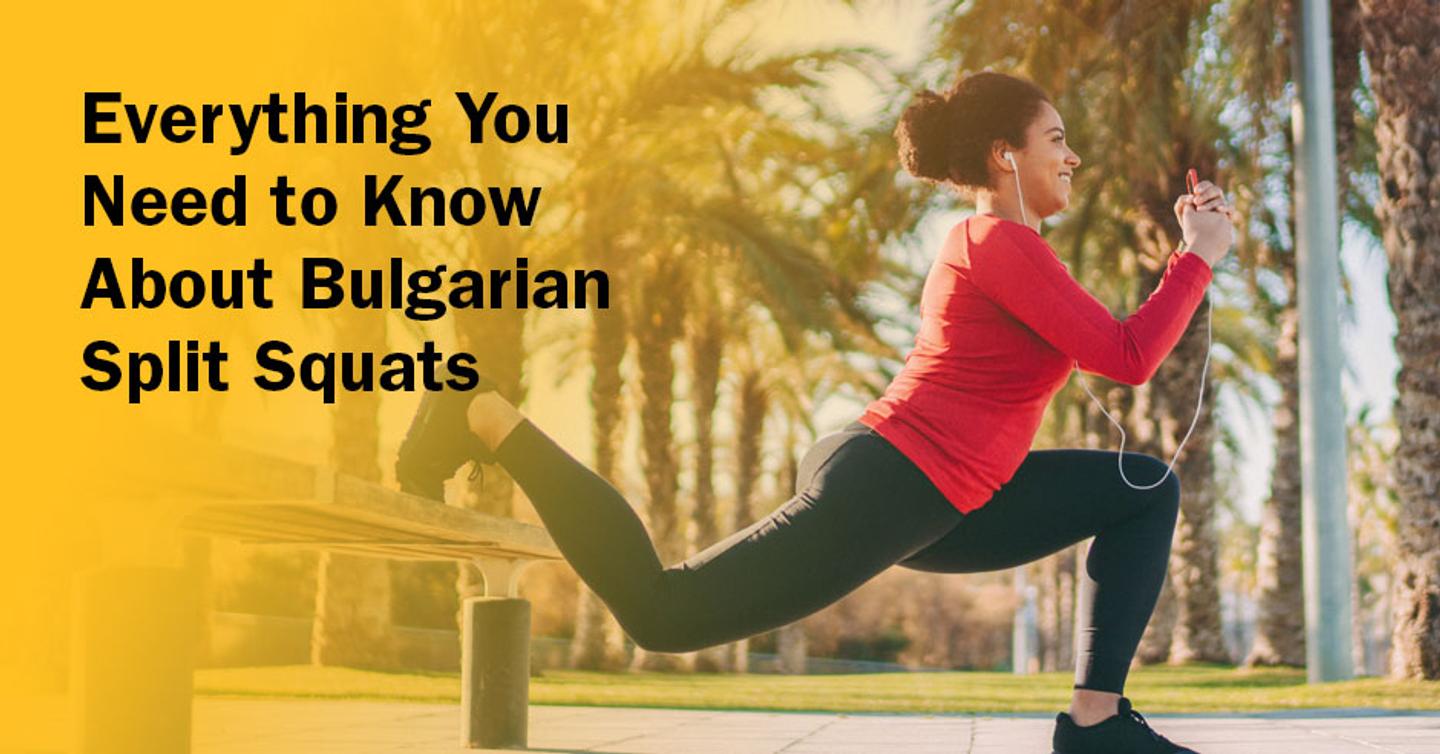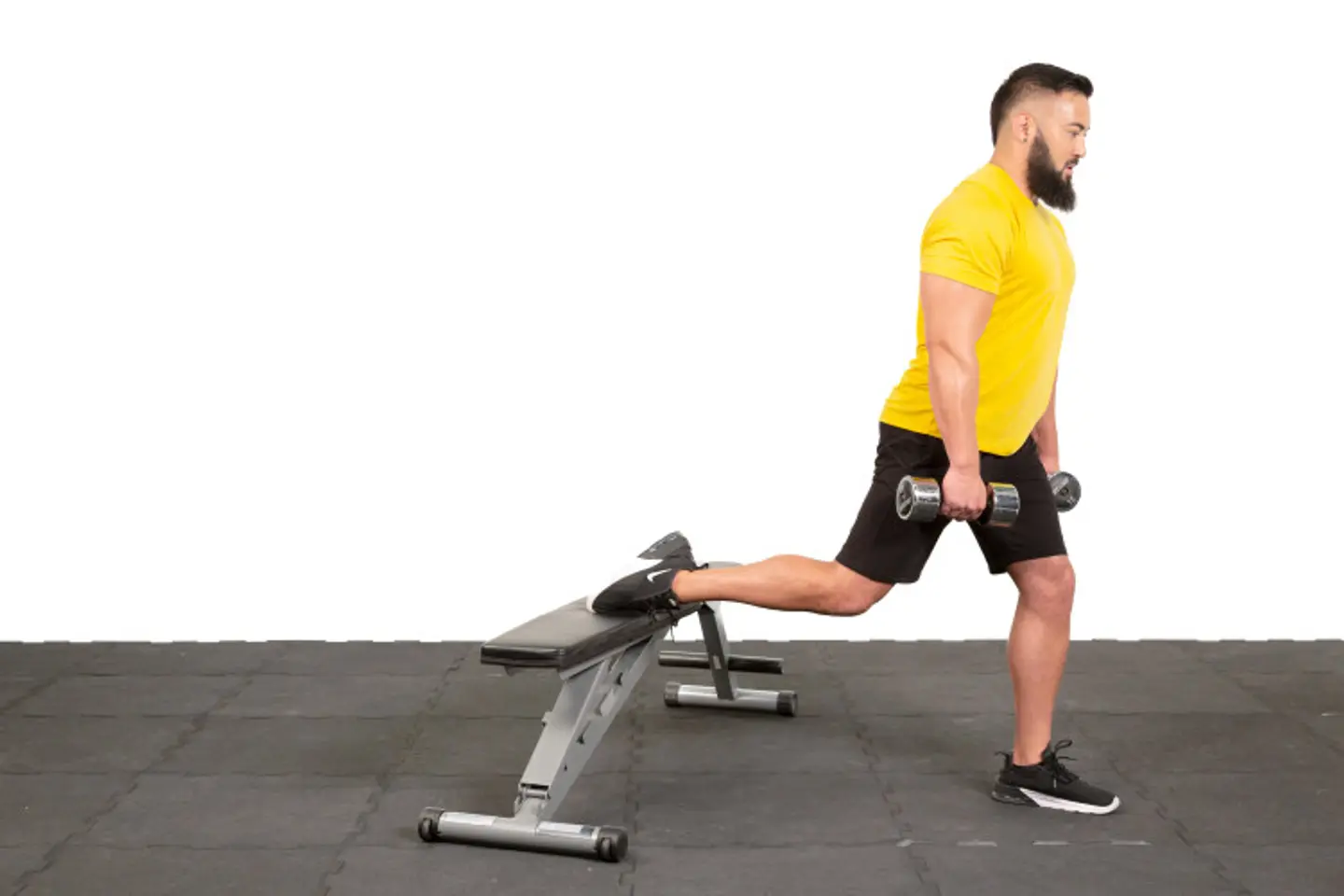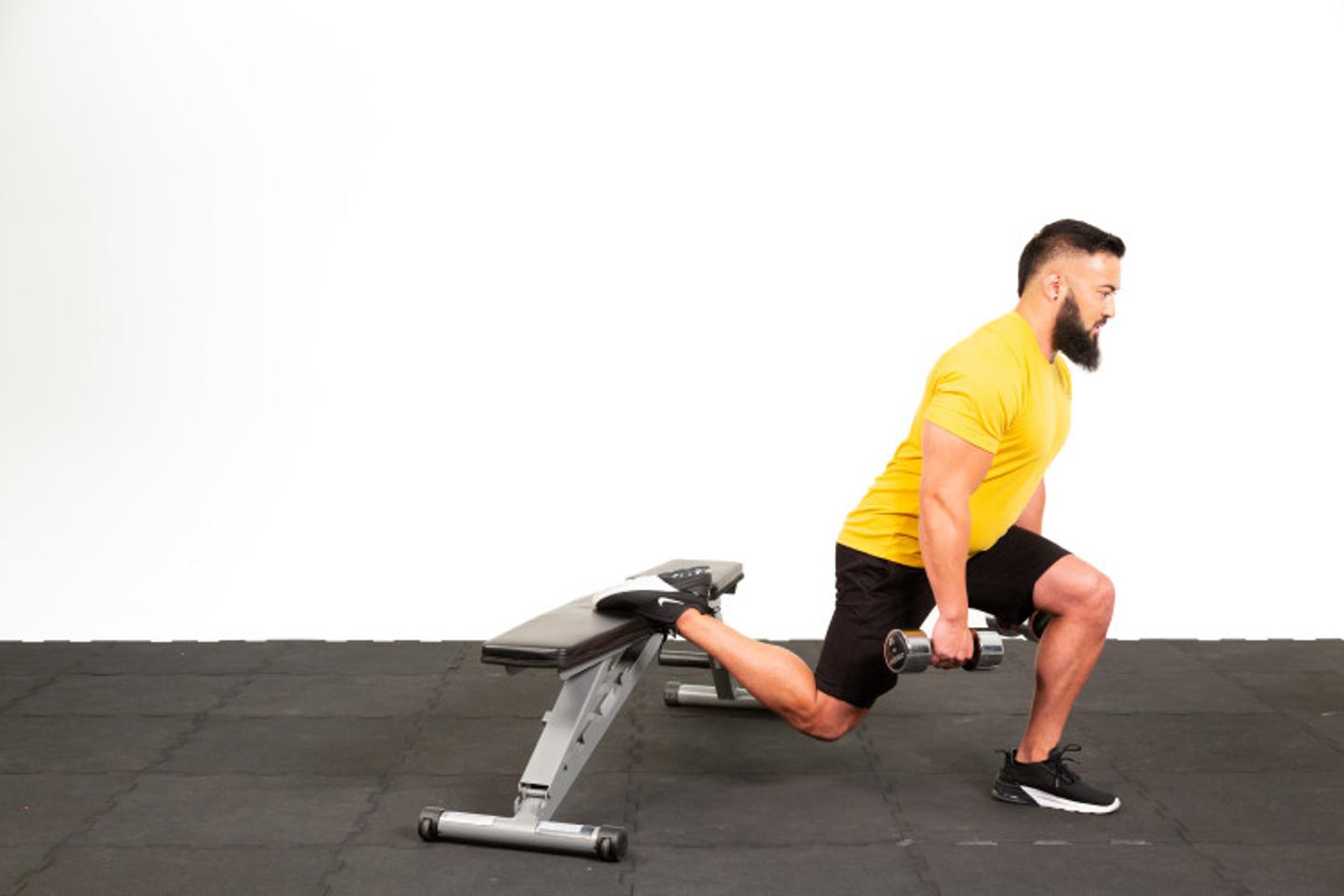
Bulgarian Split Squats: Muscles Worked, Benefits, Form, Variations
Reading Time: 6 minutes
BY: ISSA
DATE: 2023-01-30
A Bulgarian split squat is a challenging compound movement for building overall lower body strength. As a bonus, it works the core too. If you haven’t added this to your strength routine yet, now is the time.
Master the form to do this move safely or to help your clients use it as they progress into more difficult strength workouts.
What is a Bulgarian Split Squat?
A Bulgarian split squat is a variation of a regular split squat with the back leg elevated. It could also be considered a variation of a single leg squat. When you do a standard single leg squat, you put your stabilizing leg in front of your body while balancing and squatting on the loaded leg.
When doing a Bulgarian split squat, that balancing leg goes behind your body. As with a single leg squat, it remains elevated for the movement, but it doesn’t just hang out there in the air. Instead, it rests on a strap, bench, or another surface.
What Muscles Do Bulgarian Split Squats Work?
Like other compound, lower body movements, the Bulgarian split squat works several muscles at once:
Quads
Glutes
Hamstrings
Calves
Core, including abdominals and spinal erectors
The positioning of the split squat puts more load in the quads than in traditional squats. Depending on how you situate your forward foot and how deep you squat, you can shift some of that load to the glute muscles.
Whether it's for function, form, or figure - better glutes are often the #1 focus for clients. Make your clients' ideal glutes a reality with the first and only certification of its kind - get certified as a Glute Specialist with ISSA!
Benefits of Adding the Bulgarian Split Squat to Your Strength Rotation
The Bulgarian split squat is a must-have exercise for a lower body strength workout plan. It works several muscles, improves stability and core strength, and is easier to do if you have lower back or knee issues.
Add a New Challenge to Your Lower Body Workout
Compound lower body strength exercises work several muscles at once, support stability, and provide a challenging and efficient workout. From a regular squat to a Bulgarian split squat, you’re taking your compound movement to the next level.
This single leg exercise requires all the same muscles as a traditional squat but focused on one side and with good balance. It’s more challenging and is a great way to progress a lower body workout.
Learn more: This guide is the definitive list of the best exercises to build leg strength.
Bulgarian Split Squats Improve Stability
Any move that involves one leg at a time involves balance. To do this move correctly requires balancing heavily on the forward leg. Balancing exercises work and strengthen the core, which makes you more stable overall. Stability is important for athletic performance but also for avoiding injuries and falls, especially in older adults.
Avoid or Work on Muscle Imbalances
Whenever you isolate one leg or one side of the body, you have a chance to correct any imbalances. It’s not unusual to favor or have more strength in one side than the other. Focusing on one leg at a time with a single leg exercise like this means you can’t rely on the stronger leg. The weaker leg has to do the work and gets stronger as a result.
Take the Pressure off Your Back and Knees
A study comparing the biomechanics of a back squat and a split squat found that the latter involves significantly less displacement of the knee joint. This means that if you or a client struggles to do squats because of knee issues, you may be able to do the Bulgarian split squat without pain or risk of injury.
It may also be a better option for anyone with lower back pain. Other types of squats, especially back squats, put so much load on the back. Bulgarian split squats do not. Give it a try for a client with back issues but go slowly.
How to Do a Bulgarian Split Squat Correctly
As with any strength move or exercise, form is everything. Without good form, you won’t get all the benefits. In a worst-case scenario, you can even cause an injury. Here’s how to do a Bulgarian split squat, step by step:
For your starting position, stand about two feet in front of a box or bench. Make sure it’s sturdy and stable. Place your feet at about hip-width or slightly wider.
Place your right foot on the bench behind you. You can either rest the top of your foot on the bench, or flex at the ankle and put your toes and the ball of your foot on the bench. Use whichever feels most comfortable.
Keeping your chest upright, bend the left knee and dip down. Keep your weight on that forward, leg. The rear, right leg should be relaxed as it bends with the left knee.
Let your hips hinge forward a little and allow the knee to extend to or just over the toes of your forward left foot.
At this point, you can adjust the position of the forward foot, finding the distance from the box that is most comfortable.
Focus on activating the left glutes and quads as you push back up to standing.


Common Mistakes with the Bulgarian Split Squat
Once you find the best positions for your feet, getting the form right isn’t difficult, but watch out for these mistakes:
Do not align one foot directly behind the other. They should remain at least shoulder-width apart for the duration of the movement.
Avoid leaning too far forward. Your core should be working to keep you stable and upright.
Do not rise up on your toes. If you find yourself doing this, you may need to move your front foot farther forward.
Keep the focus on the front leg. The rear foot or rear leg should not be doing the work.
Don’t let the front knee wobble in or out. It should stay straight forward and aligned with the foot.
Bulgarian Split Squat Progressions and Variations
Once you or your client has mastered this move, you can make it more difficult or try variations:
Add a Weight for a Dumbbell Bulgarian Split Squat
As a bodyweight exercise, this is a powerful movement, but it will eventually get easier. Hold a dumbbell just in front of your body as you do the move to make it more challenging and to progress. You can also hold one dumbbell or kettlebell in each hand down at your sides.
If you don’t have weights, use resistance bands. Place the band under your forward foot and hold the other side in your hands. Increase the resistance by shortening the band or using one with greater resistance.
Emphasize the Quads or the Glutes
You can put a greater load on and work the quadriceps more if you take a wider stance when doing this exercise. Place the forward foot farther in front of the bench. To target the glutes more, bring this foot in closer. You should feel the difference.
Boost the Core Workout with a Stability Ball
Your core muscles are tested in this squat variation by trying to keep the body balanced and upright. Add to the challenge by switching out the stable bench for a stability ball. Go slow with this and use a spotter until you’re confident you won’t topple over and get hurt.
Bulgarian split squats add a new challenge to lower body days. Learn to master this move for an efficient, all-around strength move that also improves stability and balance.
Sample Strength Workout with Bulgarian Split Squats:
Complete 4 sets of each block, and alternate between the two exercises. Take 3-5 minutes of rest in between each exercise.
Begin with a dynamic warm-up and movement prep, such as band work, PVC warm-ups, or lower body dynamic movements.
A. Barbell Back Squat: 4 sets of 5 reps
A. Dips: 4 sets of 6 reps each arm
B. Barbell Deadlift: 4 sets of 5 reps
B. Pull-ups: 4 sets of 6 reps
C. Bulgarian Split Squat: 4 sets of 6 reps each leg
C. Dumbbell Incline Press: 4 sets of 5 reps
Finish with static stretching focusing on the upper back, shoulder region, and lower body musculature.
Level Up Your Training
Learn how to break down and teach this move and other exercises to help clients meet their goals. ISSA’s Certified Personal Trainer – Self-Guided Study Program is everything you need to become a professional trainer, and it’s all online. Get started today!
Featured Course
ISSA | Certified Personal Trainer
Start your dream career completely online! Take the course, pass the certification final exam, and be guaranteed a job - or your money back!
References
Mackey, E. R., & Riemann, B. L. (2021). Biomechanical Differences Between the Bulgarian Split-Squat and Back Squat. International journal of exercise science, 14(1), 533–543.